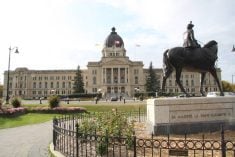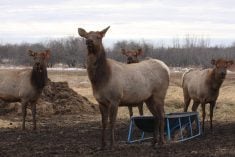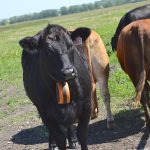Rural residents across much of the West have returned to business as usual following last week’s blizzard that wholloped a huge swatch of the central Prairie killing three people.
A 57-year-old woman from Leader, Sask., was found dead Jan. 11 after her car overturned on slippery roads east of Shaunavon, Sask. RCMP sgt. Brad Kaeding suggested the woman may have become disoriented when she left the vehicle after it ended up facing the opposite direction.
On Jan. 10, two people were found frozen to death on the Onion Lake First Nation north of Lloydminster after walking when their vehicle hit a ditch.
Read Also

Why feds imposed EV tariffs
Moe and Kinew have a fight on their hands when it comes to eliminating the EV tariff. Canada has to worry about pissing off the U.S. and Mexico and hundreds of thousands of auto workers.
For many other rural residents, the driving snow and fierce winds made life harried, as rural roads, schools and businesses were closed and travel became impossible on major highways. Many farmyards were snowed in.
Thousands of kids got at least two snow days at home after drifting snow stopped buses from travelling on rural roads.
“The kids enjoyed it,” said Luke Perkins, president of the Saskatchewan Elk Breeders Association.
The elk on his Star City, Sask., farm didn’t seem to mind the blasting from the snow despite winds reaching 90 km-h in some parts of the province.
“The beauty of elk is they hunker down and take it. I guess if you had chickens you might be looking for them,” said Perkins, who hasn’t seen any ill effects from the storm.
Dan Kulak, a warning preparedness meteorologist with Environment Canada, said an intense low pressure system from British Columbia on Jan. 9 walloped the northern areas of British Columbia, Alberta and Saskatchewan before fading away Jan. 11.
The worst hit areas were along the Yellowhead Highway in a line from the British Columbia Peace region, north of Edmonton, through Lloydminster, Saskatoon and Yorkton.
The Peace River region received the most snow in B.C., where 10 to 20 centimetres fell. Winds gusted to 80 km-h at Lloydminster during the peak of the storm. About 15 to 25 cm of snow fell on the parkland regions of Saskatchewan.
Environment Canada said it was one of the strongest blizzards to hit central Saskatchewan in several years.
“Saskatoon really got nailed,” said Kulak.
Herb Pfau, superintendent of public works for the County of Grande Prairie, said the shifting winds blocked almost every kilometre of road in the county. Crews spent nearly three days digging out the 3,200 kilometres of gravel and 120 km of paved roads in the northern Alberta county.
The storm started from the north and then shifted to the west blocking both north-south and east-west roads.
“This one clobbered us both ways.”
The county sent out 17 graders, three larger tractors with blades, three plow trucks, two loaders, three caterpillars and two backhoes to clear the two metre high drifts from the road. They also had help from forestry workers, farmers and members of the oil and gas industry who plowed trails through the drifts.
“The roads may not be pretty, but they’re passable.”
Brian Doig, Saskatchewan’s livestock development specialist in North Battleford, said many farmers were prepared for the storm they knew was blowing their way.
“They fed ahead of the arrival of the blizzard and everything was bedded in,” said Doig.
Pat Creech of Lloydminster said their crew did the necessary chores feeding cattle and went home to wait out the storm, which lasted about 15 hours around the border city. Dealing with the day-long storm wasn’t as bad as living with this winter’s large snowfalls.
“It has been hard with all this snow. We’ve got snow everywhere,” she said.
Environment Canada said despite the blizzard, the Prairies are still under an El Nino weather system expected to continue with warmer than normal temperatures until March.














